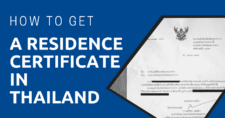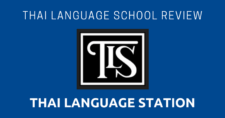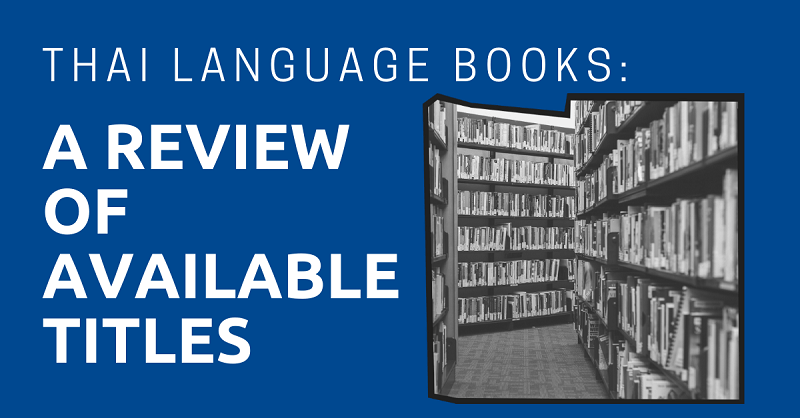
Books are probably the oldest way of learning a language and there are real benefits to them. You can see what’s on the page, it doesn’t go away, and they are relatively portable. The downside is that you aren’t getting immediate feedback on what you are learning and while you can learn vocabulary and grammar, conversation will come very difficult.
It’s also hard to get tones correctly out of a book so you may end up sounding like you have marbles in your mouth when you are asking where the bathroom is. Many of the books have audio components but if you are like me you probably lost them.
Enter your email below to receive our FREE Thai Language Cheat Sheet. It includes a comprehensive list of downloadable PDFs to quickly get you started learning the Thai language. The Cheat Sheet covers everything, from the alphabet, tone marks, and consonant sounds to vocabulary and much more.
Disclaimer: This article may include links to products or services offered by ExpatDen’s partners, which give us commissions when you click on them. Although this may influence how they appear in the text, we only recommend solutions that we would use in your situation. Read more in our Advertising Disclosure.
Contents
Beginner Books
Thai for Beginners
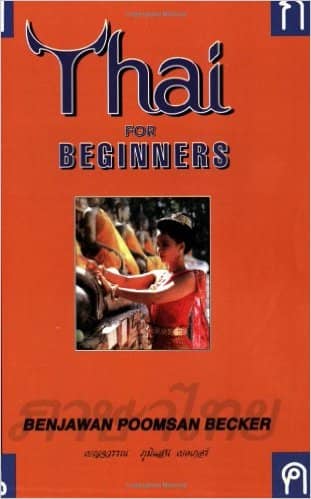
Thai for Beginners is one of the easiest Thai language books to get a hold of. It is also one of the oldest. Published in 1995 the book is supposed to come with cassette tapes or cds to help with the audio version. I recently purchased a copy without tape or cd – but those are antiquated technologies anyways so mai bpen rai (never mind).
The book is a fairly good place to start for beginners, especially as it is so available and inexpensive. That said the author does introduce a phoentic version of Thai which can be very distracting for Thai learners. Since the language is phoentic, and, unlike english, words actually sound exactly as they are written. Learning the alphabet and tone rules would be a wiser move than spending time learning how to speak a made up secondary language.
Although there is an official transliteration system, every book and company will use a different transliteration system. This makes learning transliteration is basically useless. Interestingly enough Becker, the author of Thai for Beginner, give advises against relying on transliteration – it’s worth quoting at length:
“The phoentic Thai alphabet will assist even basic conversation. Using the Thai writing system develops speaking and listening skills as well as reading and writing. Wean yourself off of transliteration as soon as possible. You won’t regret the extra effort spent learning the Thai writing system.”
A lot of people found issue with Becker’s use of phonetic Thai, “I am finding this book very useful, but it gets confusing because it and another book I have use different romanization systems/phonetic usages that sometimes don’t correlate,” one reviewer wrote on Goodreads.
Becker also introduces some handy writing guides helping you to practice penning the alphabet from the get go. She breaks down the alphabet appropriately into middle, high and low consonants along with short and long vowels. The quizzes in the book help reinforce the lessons learned in each chapter as well.
The major cons of Thai for Beginners is that some of the sentences can be a bit formal or sound a little off. For example in a conversation between two friends on the phone, Becker uses quite a formal word of ทาน Tan (to eat) instead of the more colloquial กิน Kin. There’s nothing wrong with being formal and polite, but it is odd when used in regular speech among friends and peers. But who knows maybe you want to treat your friends with all the respect they deserve – or you know, you are like me and you don’t.
While Becker’s book is the most popular resource, it is dated, and the layout makes it difficult to study from.
Everyday Thai for Beginners
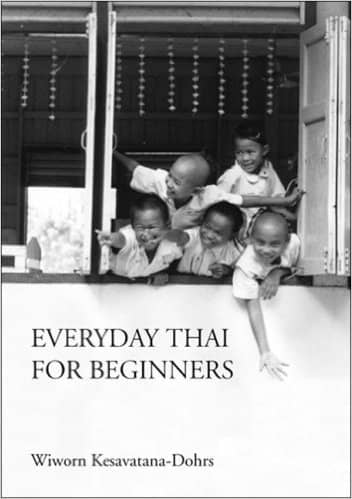
Published in 2007, Everyday Thai for Beginners has a more updated look and feel to it. The layout of the book is better, making it easier to read and study than Thai for Beginners. One of the real pros, or cons depending on your point of view, is that there is no phoentic Thai-english. All of the instruction is in either English or Thai. This is a great resource if you already know the alphabet and can pronounce basic consonant clusters. Wiworn Kesavatana-Dohr’s work is a tremendous aid in learning how to read and write which as I’ve stated before is very helpful in learning Thai as the language is phoentic.
Some reviewers over on Amazon recommend learning the alphabet with Thai for Beginners and then more heavily relying on the use of Everyday Thai for Beginners. This is certainly a solid suggestion as Everyday Thai for Beginners doesn’t teach one the alphabet initially. Instead, it assumes that the students already knows the letters and vowels.
The book begins with tone rules as a foundation for learning and proceeds on to the usual topics of greetings, family relations, everyday life, time, food, directions and running errands. In addition to the usual drills and quizzes are the cultural corner notes. A lot of language is also about culture as the two shape each other in a constant give and take.
For example, Kesavatana notes that Thais mainly call each other by their first names, and that when you are introduced to someone usually only the first name is given. This is not the legal name but rather a nickname, usually the nickname will be one syllable like Pear, Ploy, Dam, or Beer. Legal names are usually longer and can be a bit difficult on the foreign tongue.
In addition, during conversation, Thais will often omit pronouns when it is already understood by the speakers – of course for early language learners that understanding might not be there and knowing how the language works will help bridge that gap.
I’d really recommend this book as a solid resource. It is mid priced, pretty available and in general a real handy useful guide.
Intermediate Books
Thai for Intermediate Learners
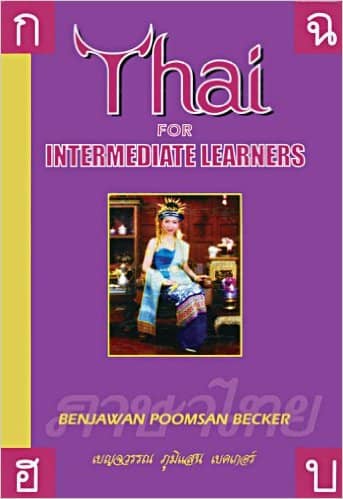
In the series of Becker’s books, she also published a book for an intermediate learner called Thai for Intermediate Learners. In the introduction, she again advises students to learn how to read and write, “Since it uses a phonetic alphabet, reading and writing Thai reinforces the other skills.” The intermediate book was published in 1998 and has a very similar lay out and structure as Thai for Beginners.
It is basically an expansion of lessons already learnt from the Beginners book with more information on directions, provinces, ให้ hai (to give), ความ kwam (the substance, sense of), and ใจ jai (heart/emotion) amongst other subjects.
Like Thai for Beginners, the Intermediate book has vocabulary lists and tests at the end of each chapter. It feels a bit old but is readily available, I would recommend getting this one when you are in a real pinch for a learning Thai book. It is basically an extension of Thai for Beginners with all of its good and bad qualities.
Thai Reference Grammar
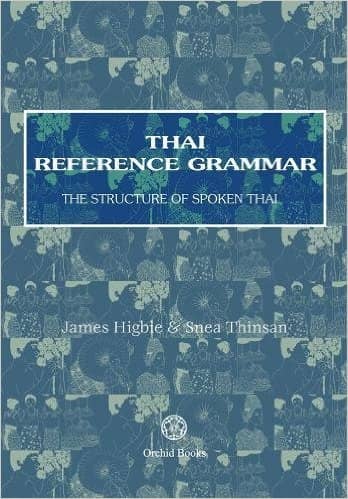
Thai Reference Grammar is mammoth and probably the type of book that is good for those who need to know the structure of a language as well as word variations to speak it. Published in 2002 by James Higbie and Snea Thinsanreally lay down the language law of what’s what.
The duo puts together 400 pages, plus a comprehensive index, on the ins and outs of Thai. There is of course a transliterated language that dominates which is a bit vexing and visually gets in the way. Anyone that would pick up this book should already be familiar with Thai.
An example from the work is the part in which they describe the four different ways to say “usually.”
First there is the word ธรรมดา tham-ma-da which means ordinarily, regularly, habitually and is also an adjective meaning regular.
It is “usual” that a man would like a good woman like you.
มันเป็นธรรมดาที่ผู้ชายจะชอบผู้หญิงดีอย่างคุณ (Mun pen tham-ma-da thee phoo-chai ja chawp phoo-ying dee yang koon)
The second way to say usually is through the more formal word of ปกติ pok-ga-tee. There is a slight variation as ปกติ means “routinely”, “usually”, “regularly” and is also “normal” in medical tests.
I usually go to bed at nine p.m.
ฉ้นนอนสามทุ่มโดยปกติ (Chan nawn sam thoom doy pok-ga-tee)
The third way is to use มักจะ. This phrase means “usually” and “likely to.” It can also mean “inclined to” and “frequently”. The phrase is put before the verb and sometimes the จะ is omitted but usually it’s included.
In this season it usually rains heavily
หน้านื้ฝนมักจะตกหนัก (Na nee fon mak ja tok nak)
The last way to say usually is to use the phrase ส่วนมาก which mean “mostly” or “most of the time.” This phrase can also modify nouns in phrases like “most Thais” (คนไทยส่วนมาก)
I usually don’t drink beer. I like to drink wine.
ส่วนมากผมไม่กินเบียร์ ผมชอบกินไวน์ (Suan mak phom mai gin bia. Phom chawp gin wai)
If your target of learning Thai is just only for a basic conversation, knowing different words with similar meaning is not necessary at all. Well normally you want to mix up your sentences, so you regularly don’t say the same thing routinely. Most of the time using just one vocabulary word is sufficient and no matter how you say “usually”, you are likely to get your meaning across.
Punny phrases aside, this book is probably the most in-depth of the learning Thai books – that doesn’t necessarily mean it’s worth having for everyone though. I would suggest this book to fairly advanced students of Thai. It’s layout and scholastic tone invoke authority but don’t invoke an easy way to learn.
A reviewer over at LearnThaiReviews summed it up nicely stating “I will say that this book is kind of boring to read and you probably could not just sit down and read it from cover to cover. However, it is a great reference book or a book to just pick up here and there and learn some grammar structures.”
It is a nice addition to the learned student of Thai. Otherwise, if your goal is only for basic daily life conversation, it is better to give it a pass.
Thai: An Essential Grammar
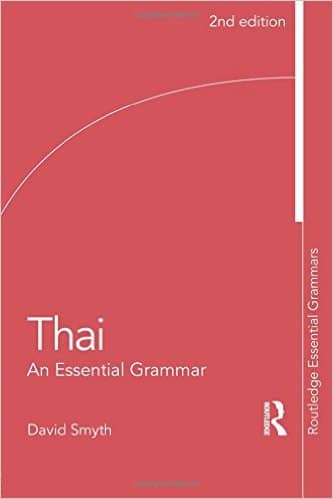
Thai: An Essential Grammar by David Smyth, a lecturer of Thai at the School of Oriental and African Studies at University of London, has a very similar feel and structure as Everyday Thai Language. However it is used more as a regular grammatical book. Smyth set out to create a “concise and user-friendly guide to the basic structures of the language” and successfully accomplished that.
Published in 2002, Thai: An Essential Grammars feels up to date and again starts out with a pronunciation guide. Smyth recreates the wheel and formulates a transliterated language with the usual consonants, final consonants, clusters, vowels and diphthongs. He does state that “Overall, the match between spelling and pronunciation in Thai is remarkably close; if you know the rules, you can almost guarantee that you will be able to read the word correctly.“
Not to beat the Som Tum to death, but here again is another reason to learn how to read and write. There are a few cases in which pronunciation and spelling don’t match as Smyth points out. First there is when tone suggested by spelling is not reflected in pronunciation, mainly words written with rising tones but pronounced with high towns. Then when vowel length (there are short and long vowels in Thai) is not reflected in pronunciation and a few other cases of odd consonant clusters.
This book isn’t the best learning guide but it is a great resource to learn further grammar and structural lessons. I’d recommend it as one of the better secondary resources out there.
One reviewer felt that the book was a bit stronger than I did, writing that “I love its cross between a grammar book with a stiff upper lip and a useable phrasebook. It basically taught me to read and write Thai and pull out a perfect phrase when the opportunity arose.“
It certainly is a more lively of a grammar book, especially when compared to Thai Reference Grammar. It is a welcome addition to the resources on your bookshelf. Probably not the best first buy. I would first get Everyday Thai for Beginners.
100 Thai Words to Make You Sound Thai
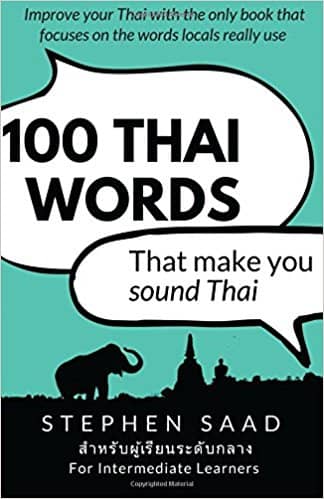
Rather than just a list of phrases, 100 Thai Words That Make You Sound Thai: Thai For Intermediate Learners offers example sentences of the phrases in use with insights as to when to use them in conversation. I like this as I know if a phrase is formal or informal and how you can use it naturally. The phrases are useful and will allow you to move beyond the simple question and answer format that most beginners find themselves in. The book also highlights which phrases are often used by men or women and uses a scale to show how much emotion is attached to a word which both help to avoid using it in the wrong context. Speaking to a few younger Thais they did mention that some of the phrases were used by middle aged or older Thais but then if you fall into this bracket they will be appropriate for you to use.
100 Thai Words to Start Speaking Thai
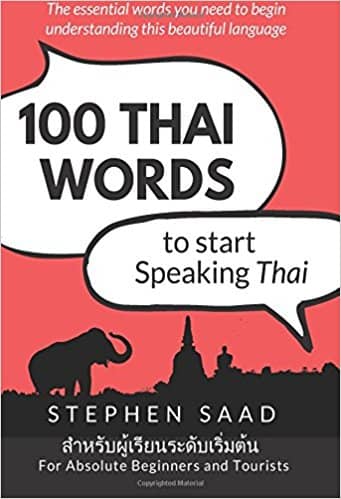
100 Thai Words To Start Speaking Thai: For Absolute Beginners and Tourists is the bridge between a phrase book and a full-fledged language book. I like that it is simple enough to read a couple of pages to get a phrase with a little context and some example sentences. Most phrases are pretty useful and are the kind of words you might use every day. There are a range of verbs, greetings, places and emotions to help you have a basic conversation. There is also Thai script for those looking to practice reading. The method for pronunciation takes a while to get used to but works.
Other Resources
The above lists some of the most common, and the most useful ones. There are a slew of other resources out there and this site has a great run down of some others that are available.
One important part to remember is that learning Thai from book alone is not enough. Even though being one of the best options to learn reading and writing, it does not help much in term of speaking and reading. You should consider going out and talk to locals in order to improve your language skills. If that is not an option, there are various Thai learning methods to help you on that.


